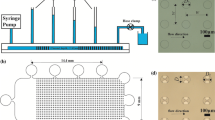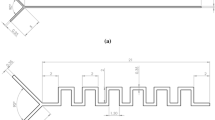Abstract
Microfluidic channels with integrated pillars are fabricated on SU8 and PDMS substrates to understand the capillary flow. Microscope in conjunction with high-speed camera is used to capture the meniscus front movement through these channels for ethanol and isopropyl alcohol, respectively. In parallel, numerical simulations are conducted, using volume of fluid method, to predict the capillary flow through the microchannels with different pillar diameter to height ratio, ranging from 2.19 to 8.75 and pillar diameter to pitch ratio, ranging from 1.44 to 2.6. The pillar size (diameter, pitch and height) and the physical properties of the fluid (surface tension and viscosity) are found to have significant influence on the capillary phenomena in the microchannel. The meniscus displacement is non-uniform due to the presence of pillars and the non-uniformity in meniscus displacement is observed to increase with decrease in pitch to diameter ratio. The surface area to volume ratio is observed to play major roles in the velocity of the capillary meniscus of the devices. The filling speed is observed to change more dramatically under different pillar heights upto 120 μm and the change is slow with further increase in the pillar height. The details pertaining to the fluid distribution (meniscus front shapes) are obtained from the numerical results as well as from experiments. Numerical predictions for meniscus front shapes agree well with the experimental observations for both SU8 and PDMS microchannels. It is observed that the filling time obtained experimentally matches very well with the simulated filling time. The presence of pillars creates uniform meniscus front in the microchannel for both ethanol and isopropyl alcohol. Generalized plots in terms of dimensionless variables are also presented to predict the performance parameters for the design of these microfluidic devices. The flow is observed to have a very low Capillary number, which signifies the relative importance of surface tension to viscous effects in the present study.


















Similar content being viewed by others
References
Barraza HJ, Kunapuli S, O’Rear EA (2002) Advancing contact angles of Newtonian fluids during high velocity, transient, capillary driven flow in a parallel plate geometry. J Phys Chem B 106:4979–4987
Bayramli E, Powell RL (1989) The normal (transverse) impregnation of liquids into axially oriented fibre bundles. J Colloid Interface Sci 138(2):346–353
Brackbill JU, Kothe DB, Zemach C (1992) A continuum method for modeling surface tension. J Comp Phys 100:335–354
Chakraborty S (2005) Dynamics of capillary flow of blood into microfluidic channel. Lab Chip 5:421–430
Chakraborty S (2007a) Order parameter modeling of fluid dynamics of narrow confinements subjected to hydrophobic interactions. Phys Rev Lett 99:094504
Chakraborty S (2007b) Towards a generalized representation of surface effects on pressure-driven liquid flow in microchannels. Appl Phys Lett 90:034108
Chakraborty S (2007c) Electroosmotically driven capillary transport of typical non-Newtonian biofluids in rectangular microchannels. Anal Chim Acta 605:175–184
Chakraborty S, Mittal R (2007) Droplet dynamics in a microchannel subjected to electrocapillary actuation. J Appl Phys 101:104901
Chakraborty S, Das T, Chattoraj S (2007) A generalized model for probing frictional characteristics of pressure-driven liquid microflows. J Appl Phys 102:104907
Chakraborty S, Tsuchiya K (2008) Development and fluidic simulation of microneedles for painless pathological interfacing with living systems. J Appl Phys 103:114701
Chakraborty S, Dinkar AK (2008) Implications of hydrophobic interactions and consequent apparent slip phenomenon on the entrance region transport of liquid through microchannels. Phys Fluids 20:043602
Chen YF, Tseng FG, Chien SYC, Chen MH, Yu RJ, Chieng CC (2008) Surface tension driven flow for open microchannels with different turning angles. Microfluid Nanofluid 5(2):193–203
Hirt CW, Nichols BD (1981) Volume of fluid (VOF) method for the dynamics of free boundaries. J Comp Phys 39:201–225
Huang W, Liu Q, Li Y (2006) Capillary filling flows inside patterned-surface microchannels. Chem Eng Technol 26:716–723
Jensen MJ (2002) Bubbles in microchannels. MSc thesis, Technical University of Denmark, Denmark
Jimack PK (2004) Adaptive algorithms for free-surface flow problems. In: Proceedings of the 4th international conference on engineering computational technology, Lisbon, Portugal, pp 1–24
Jokinen V, Franssila S (2008) Capillarity in microfluidic channels with hydrophilic and hydrophobic walls. Microfluid Nanofluid 5:443–448
Kern P, Veh J, Michler J (2007) New developments in through-mask electrochemical micromachining of titanium. J Micromech Microeng 17:1168–1177
Kim B, Peterson ETK, Papautsky I (2004) Long-term stability of plasma oxidized PDMS surfaces. In: Proceedings of the 26th annual international conference of the IEEE EMBS, San Francisco, pp 5013–5016
Lin CM (2004) Enhancement of underfill capillary flow in flip-chip packaging by means of the inertia effect. IEEE Trans Adv Packag 27(3):533–539
Lin CM, Chang WJ, Fang TH (2007) Flip-Chip underfill packaging considering capillary force, pressure difference, and inertia effects. J Electron Packag 129:48–55
Losey MW, Jackman RJ, Firebaugh SL, Schmidt MA, Jensen KF (2002) Design and fabrication of microfluidic devices for multiphase mixing and reaction. J Microelectromech Syst 11(6):709–717
McDonald JC, Whitesides GM (2002) Poly(dimethylsiloxane) as a material for fabricating microfludic devices. Acc Chem Res 35(7):491–499
Mery E, Ricoul F, Sarrut N, Constantin O, Delapierre D, Garin J, Vinet F (2008) A silicon microfluidic chip integrating an ordered micropillar array separation column and a nano-electrospray emitter for LC/MS analysis of peptides. Sens Actuators B 134:438–446
Nissila T, Sainiemi L, Sikanen T, Kotiaho T, Franssila S, Kostiainen R, Ketola RA (2007) Silicon micropillar array electrospray chip for drug and biomolecule analysis. Rapid Commun Mass Spectrom 21:3677–3682
OpenCFD Ltd (2008) OpenFOAM user guide. Version 1.5 ed
Probstein R (1994) Physicochemical hydrodynamics. Wiley, New York
Quinte A, Halstenberg S, Eggert H (2001) Use of numerical methods for modeling and simulating capillary driven flows in microchannels. Nanotech 2001:250–253
Rusche H (2002) Computational fluid dynamics of dispersed two-phase flows at high phase fractions. PhD thesis, Imperial College, University of London, London
Seemann R, Kramer EJ, Lange FF (2004) Patterning of polymers: precise channel stamping by optimizing wetting properties. New J Phys 6:110
Sethian JA, Smereka P (2003) Level set methods for fluid interfaces. Ann Rev Fluid Mech 35:341–372
Son SU, Seo JH, Choi YH, Lee SS (2006) Fabrication of a disposable biochip for measuring percent hemoglobin Alc (% HbAlc). Sens Actuators A 130–131:267–272
Thorslund S, Larsson R, Bergquist J, Nikolajeff F, Sanchez J (2008) A PDMS-based disposable microfluidic sensor for CD4+ lymphocyte counting. Biomed Microdevices 10:851–857
Tseng FG, Yang ID, Lin KH, Ma KT, Lu MC, Tseng YT, Chieng CC (2002) Fluid filling in micro-fabricated reservoirs. Sens Actuators A 97–98:131–138
Ubbink O, Issa RI (1999) A method for capturing sharp fluid interfaces on arbitrary meshes. J Comp Phys 153:26–50
Wan JW, Zhang WJ, Bergstrom DJ (2005) Influence of transient flow and solder bump resistance on underfill process. Microelectron J 36(8):687–693
Wan JW, Zhang WJ, Bergstrom DJ (2007) Recent advances in modeling the underfill process in flip-chip packaging. Microelectron J 38:67–75
Washburn EW (1921) The dynamics of capillary flow. Phys Rev 17:273–299
Xiao Y, Yang F, Pitchumani R (2006) A generalized analysis of capillary flows in channels. J Colloid Interface Sci 298:880–888
Zeng J (2007) On modeling of capillary filling. http://www.coventor.com/pdfs/on_modeling_of_capillary_filling.pdf. Accessed on 15-03-2007
Zimmermann M, Bentley S, Schmid H, Hunziker P, Delamarche E (2005) Continuous flow in open microfluidics using controlled evaporation. Lab Chip 5:1355–1359
Acknowledgments
The support of Suman Mashruwala Advanced Microengineering Laboratory, IIT Bombay is highly appreciated. The authors also like to acknowledge the UKIERI funding provided to S. K. Mitra and J. McLaughlin to carry out this collaborative work.
Author information
Authors and Affiliations
Corresponding author
Rights and permissions
About this article
Cite this article
Saha, A.A., Mitra, S.K., Tweedie, M. et al. Experimental and numerical investigation of capillary flow in SU8 and PDMS microchannels with integrated pillars. Microfluid Nanofluid 7, 451 (2009). https://doi.org/10.1007/s10404-008-0395-0
Received:
Accepted:
Published:
DOI: https://doi.org/10.1007/s10404-008-0395-0




